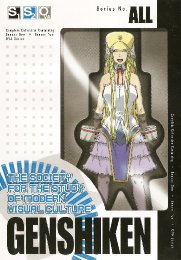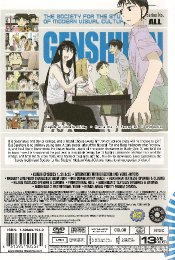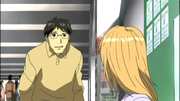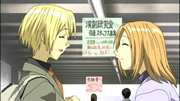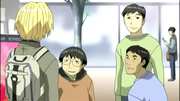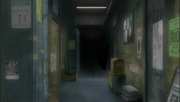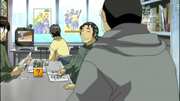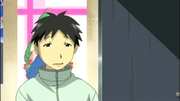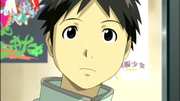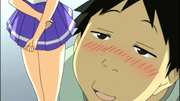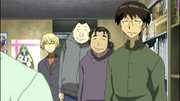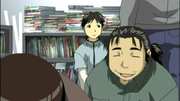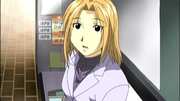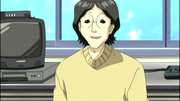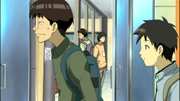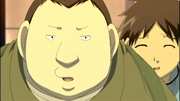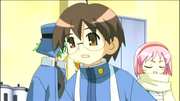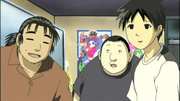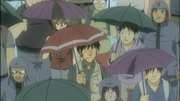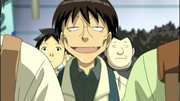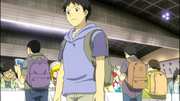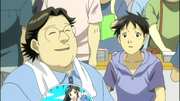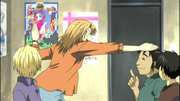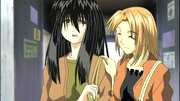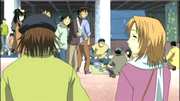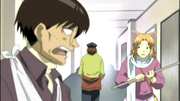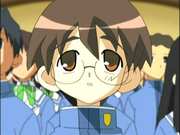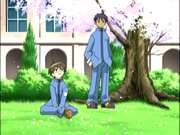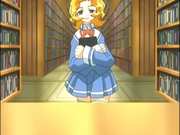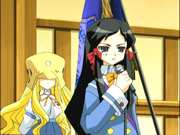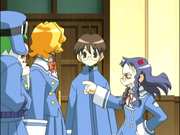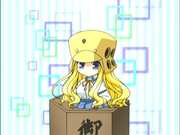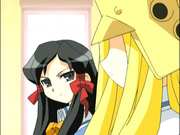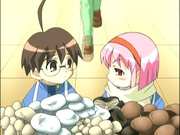Changes made to Review for Genshiken: Complete Collection
Revision 1
Created on Tuesday, 6th May 2014, 15:21
Change Submitted by Jitendar Canth
List of Changes:
-
Change #1 -
<newline>Review[page1] <newline> <newline>[heading]Introduction[/heading] <newline>Fans are a rich, and underexploited resource in storytelling and entertainment. Think of all the genre shows and movies out there, sci-fi, fantasy, action, think how many of us fall in love with particular shows, how many of us eagerly collect the DVDs, go to the cinemas, go to conventions, buy the memorabilia, meet with and debate with like-minded fans. Yet there arent many shows about us. Other than The Big Bang Theory, the rabid collector demographic is an underrepresented one in modern media. Of course its a difficult balance to find. You run the risk of alienating the very audience that youre aiming at, as its far too easy for affectionate ribbing to degenerate into outright ridicule, and also, who besides soap opera fans want to see their own lives reflected on screen? <newline> <newline>This is no less true for the world of anime and manga. Anime is replete with genres, sci-fi and fantasy, mecha and moe, while the symbiotic relationship between creators and fans is much closer than that for other forms of entertainment. When most anime producers rely on DVD and Blu-ray sales direct to fans to support their releases, they have to be even more careful in how they portray those fans, if at all. Alienate even a small percentage of your fan base and you can kiss your show goodbye. The fan, therefore usually has a small role in the background, or is the hero of the show, one that gets the girl despite his shortcomings, acting as wish fulfilment by proxy for the viewer. Shows about the fan scene are usually played for laughs, with plenty of fan service and very little realism as in Cosplay Complex or Nurse Witch Komugi. <newline> <newline>Shows that offer a realistic vision of fandom and otaku culture are just as rare in anime, as they are in other media. Welcome to the NHK is one that probably went the route of alienating its target audience, offering the dark side of obsession, exploring the NEET phenomenon that sees young adults just dropping out of society to pursue their hobbies to a self-destructive extent. That show had the advantage however of telling an absolutely gripping story. But there is a more humorous and balanced representation of the otaku out there and just as The Big Bang Theory caters for sci-fi geekdom in its humour, for anime, manga, videogame and cosplay fans out there, there is Genshiken, or The Society for the Study of Modern Visual Culture. <newline> <newline>Its the first day of college, the day when eager and awkward young freshmen are prey for the various clubs and societies on campus, looking for fresh meat. For Kanji Sasahara, timid and introverted, hes looking for something that will draw him out of his shell, but wont be too overwhelming. Hes a fan of manga, of anime, of video games and more, but the Anime Society is a little too loud and opinionated, while the Manga Society is just too intimidating. Fortunately, Genshiken is a little more laid back, as it embraces all aspects of fandom, and approaches manga, anime, games, figurines, doujinshi, cosplay, and more from the genuine otaku perspective. Genshiken also attracts the unlikeliest freshman candidate in Makoto Kohsaka, young, bright, outgoing, good looking, and who on his first day at college manages to hook up with a girlfriend, Saki Kasukabe. Kohsaka is a devil with video games. Saki thinks all otaku are weird. Things are about to get interesting in Genshiken. <newline> <newline>Media Blasters gathers their previous Genshiken releases in one mega budget boxset with seven discs. <newline> <newline>[b]Genshiken[/b] <newline> <newline>Disc 1 <newline>1. The Study of Modern Visual Culture <newline>2. Comparative Classification of Consumption and Diversion Among Modern Youth <newline>3. The Issue of Regional Cultural Advancement and its Merits <newline>4. The Sublimated Process of Mental Blocks Regarding the Dissimilation Between Dress and Costume <newline> <newline>Disc 2 <newline>5. The Boundary Between Rejection and Acceptance Seen in Autonomous Behaviour <newline>6. Subculture and its Circular Relationship to Others Surrounding It <newline>7. Characteristics of Action and Decision in Personal Relationships <newline>8. Comparative Research of the Mass Production Process <newline> <newline>Disc 3 <newline>9. Concerning Whether Explanation is Obligatory Under Certain Circumstances <newline>10. The Fetishism of Leisure Spending Taking Into Account Economic Effect <newline>11. The Position of Malice in the Phenomenon of Urban Crime <newline>12. Problems and Countermeasures Arise When an Organisation Undergoes Reconstruction <newline> <newline>[b]Genshiken OVAs[/b] <newline> <newline>13. My Name is Oguie and I Hate Otaku <newline>14. I am from the Planet Otaku <newline>15. Then Ill Undress You <newline> <newline>[b]Genshiken 2[/b] <newline> <newline>Disc 1 <newline>1. The New Chairmans Ambition <newline>2. Discord at the Meeting <newline>3. A Hot Summers Day <newline>4. Are You an Item? <newline> <newline>Disc 2 <newline>5. Madarame Total Uke <newline>6. A Question of Tastes <newline>7. Graduation Syndrome <newline>8. Cos-ken <newline> <newline>Disc 3 <newline>9. It Always Rains on the Jobhunt <newline>10. Otaku from the USA <newline>11. Real Hard-core <newline>12. What Lies Ahead... <newline> <newline>If youve just put the first disc in, and are scratching your head as to whether theyve put the wrong series on the disc, youll want to know what Kujibiki Unbalance is. Well, you cant have a show about fans without something for them to be fanatical about, and the option boils down to paying a whole lot of royalties and rights fees for an existing property, or creating one of your own. Genshikens producers created a high school tournament romance action comedy drama called Kujibiki Unbalance, and its that which you see at the start of episode one, and playing often on TV in the background of various scenes. Three whole OVA episodes were created to go along with Genshiken, and these are presented in the extras of Genshiken Season 1. <newline> <newline>In a case of life following art, the Kujibiki Unbalance OVAs proved so popular that a proper full length series was commissioned off the back of them and released the following year. When Media Blasters released that series in the US, the three Genshiken OVA episodes were included as extras with that series, although in this set they have a disc of their own. <newline> <newline>[heading]Picture[/heading] <newline>Both series and the OVA episodes get 1.78:1 anamorphic transfers, NTSC quite obviously on these US discs. The best belongs to the first series, although the quality of the transfers is identical for all. The image is clear and sharp throughout, compression is absent, and other than a few moments of aliasing, the picture quality is impressive. Its the animation quality that varies across the series. Season 1 is stupendous, with the level of detail astounding, the animation strong, and the character designs as rounded as the world design. In a show about otaku, the fan service is in the accoutrements of their obsessions, whether they are manga, DVDs, cosplaying or videogames, and the Genshiken clubroom is a treasure trove of trivia for appreciative fans watching the show. <newline> <newline>In fact both seasons and the OVAs excel in background designs. Its just when the OVAs come along, its the character designs which take a hit, losing depth and detail and becoming much simpler. The animation too takes a hit, and the OVAs are more static and limited in terms of locations and movement. The second series remedies that somewhat, but the simplified character designs do remain. Its a small drop off in quality, but it is noticeable. Fortunately, none of this diminishes the quality of the storytelling. <newline> <newline>[heading]Sound[/heading] <newline>All of the Genshiken discs get the same audio options, DD 2.0 Stereo in English and Japanese, with optional translated subtitles and a signs only track. I was happy enough with my usual choice of the original language track, and what I sampled of the English dub for Genshiken was of similar quality. Im certain that fans that prefer dubs wont be disappointed. I havent tried the English dub for the Kujibiki Unbalance OVA extras, other than to assure myself that it exists. Genshiken is a dialogue heavy show, so there isnt much call for the soundstage to be exercised. That said, the stereo did have a bit of effect when called upon. <newline> <newline>The subtitles are clear, free of error, and accurately timed. The only issues I found were in the first series, where the episode titles are extra long. In the next episode previews, the episode title was only on the signs only stream; in the subtitle stream it displayed the translated dialogue instead. Also disc 1 of the first series has an awkward layer change. The music for the show suits the story well, but I found that while the theme songs for the first series had a lot of impact, it wasnt so for the second series. Indeed, in one poignant episode in series 2, they reused the end theme from season 1 as it was more evocative. <newline> <newline>[/page1] <newline>[page2] <newline> <newline>[heading]Extras[/heading] <newline>Ironically there is a price to be paid for buying a budget collection, and with the complete Genshiken, the price comes in the packaging. The series gets a stackpack, a fat Amaray style case, one spindle, and seven discs packed atop each other. As long as no grit gets between the discs at packing, its the ideal way to transport the collection, as the likelihood of floating and scuffed discs is remote. Its just when it comes to practicality, the stackpack becomes the creation of the devil, especially if you want to watch disc 7. The first thing I did when I got the collection was to transfer each disc into its own case. <newline> <newline>Each disc, after going through the usual Media Blasters, Anime Works and Rare Flix logos, winds up at a static menu screen. The extras on each disc are as follows. <newline> <newline>[b]Genshiken Disc 1[/b] <newline> <newline>Previews for other Media Blasters releases include Ah! My Goddess, Grenadier, Giant Robo, and Fight! Iczer-One. <newline> <newline>There are six commercials for Genshiken on this disc running to a total of 2 minutes. There are no subtitles for the Japanese dialogue. <newline> <newline>The Character Show 2004 is a stage event that invited Saeko Chiba, and Akemi Kanda, who play characters in Kujibiki Unbalance, to speak about the show and about Genshiken. This lasts 8 minutes. Its followed by 7 minutes of live music from the same event, with Haruko Momoi and Under 17 Live performing the theme song from KujiUn, itself called Kujibiki Unbalance. <newline> <newline>You also get the textless credit sequences, 1 opening, and given that each closing sequence of Genshiken is different, you get all four of those here as well. <newline> <newline>Right at the bottom of the screen is the Bonus! Kujibiki Unbalance Episode. This takes you to a different 4:3 menu, which again offers you the usual options of play, scene selection, audio subtitle selection, and extras. The extras here consist of 2 minutes of commercials for Kujibiki Unbalance and the textless credits. The same Media Blasters trailers are accessible from this menu as well. At the bottom of the screen is the link to the Bonus Genshiken episodes, taking you back to the main menu. <newline> <newline>First Lot. Unbalanced Encounter (25 mins) <newline>Chihiro Enomoto starts his new school, and apart from one or two small differences, its a normal high school. Except that education here relies a lot on luck, fate, destiny, and students battling each other. The first day at school involves drawing lots to find which team each student will be in, and taking part in the first, mock-battle. Today Chihiro will make an odd group of friends, and take part in a mushroom cooking contest, as well as learn that the school chairman is a girl he once knew, and with whom he once made a very special promise. <newline> <newline>[b]Genshiken Disc 2[/b] <newline> <newline>Here you will find previews for four other Media Blasters shows, Gokusen, Otogi Zoshi, 12 Kingdoms, and Ah! My Goddess. <newline> <newline>The Interview with the Directors lasts 9 minutes, but actually joining the director Takeshi Ikehata are voice actors Takanori Ohyama (Sasahara), and Ayako Kawasumi (Kanako), as well as the creator of the original manga Shimoku Kio (although he remains anonymously off-screen) and together they have a chat about the show, and the fan scene in general. <newline> <newline>All four textless closings are here from the episodes on the disc. <newline> <newline>Once again, the Kujibiki Unbalance bonus episode gets its own menu, and this time the sole extras for it are the textless credit sequences. <newline> <newline>Twenty-First Lot: Recap Episode (26 mins) <newline>Its hard to recap a series that doesnt actually exist, but this episode does a good job in giving us the flavour of Kujibiki Unbalance, as we catch up with the various challenges that Chihiro Enomoto and his team have faced over the school year, with some quite ridiculous and humorous encounters. At least thats how they play in this episode. Stretching such encounters out to an episode apiece could make them tiresome. <newline> <newline>[b]Genshiken Disc 3[/b] <newline> <newline>This time the previews are for Otogi Zoshi, Ah! My Goddess, Seven of Seven, and Giant Robo, and once again you get all four textless closings for the episodes on this disc (although in an authoring mistake, they are squished down to 4:3, and youll have to alter them manually to get the correct aspect ratio). <newline> <newline>The main extra on this disc, and accessible from both the Genshiken and the Kujibiki Unbalance menus, is the Voice Actor Interviews. Its a 28 minute piece, taken from the Toranoana Event, where voice actors Ayako Kawasumi (Kanako Ohno Genshiken and Kasumi Kisaragi Kujiun) and Saeko Chiba (Ritsuko Kubel Kettenrad Kujiun) take to the stage to answer a few fan questions, and have an amiable chat about both of the shows. As is par for the course for these events, its a light and fairly meaningless piece with little of depth about the series. <newline> <newline>Theres also the Kujibiki Unbalance episode, which in its extras also offers its textless closing. <newline> <newline>Twenty-Fifth Lot: Kujibiki Forever (26 mins) <newline>This is the penultimate episode, which sees Chihiro and his team on the verge of succeeding at the school tournament only for last minute differences threatening to break up the team before the final battle even starts. <newline> <newline>[b]Genshiken OVAs[/b] <newline> <newline>The three episodes here are presented via a set of static menus, and noticeable by their absence are the textless credit sequences. <newline> <newline>What are presented here, accessible from the audio options menu, are the audio commentaries. Takanori Ohyama (Sasahara), Ayako Kawasumi (Ohno), and Kaori Mizuhashi (Ogiue) get together to chat over the first episode of the OVA, Nobuyuki Hiyama (Madarame), and Satsuki Yukino (Saki) on the second, and Tomokazu Seki (Tanaka), and Kenji Nomura (Kugayama) on the third. They are occasionally gappy, mostly trivial, and rarely informative, but are fun, light and enjoyable chats that are worth taking the time to listen to at least once. <newline> <newline>[b]Genshiken 2[/b] <newline> <newline>Disc 1 <newline> <newline>Here you get previews for Dojin Work, the Kujibiki Unbalance series, Bludgeoning Angel Dokoro-chan, and the Alteil online card game. <newline> <newline>Show specific extras are limited to the first set of textless credit sequences and a 90 second promotional video for Genshiken 2. <newline> <newline>Disc 2 <newline> <newline>This time the previews are for Magical Witch Punie-chan, Akihabara Geeks, Golden Boy, and The Gokusen. The only extras are the Textless credits, version 2. <newline> <newline>Disc 3 <newline> <newline>The trailers on this disc promote Golion, Ikki Tousen Great Guardians (which Media Blasters never released in the end and in fact recently cancelled altogether), Magic Knight Rayearth, and Sadamitsu. <newline> <newline>The main featurette on this disc is the Menma Special, lasting 20 minutes. Menma is the erotic videogame that Sasahara often loses himself in, and the Menma Special is a (non-erotic) radio drama featuring the characters from the game. Its presented here in subtitled (and dubbed) form, against a slideshow of character and background art from the game. <newline> <newline>[/page2] <newline>[page3] <newline> <newline>[heading]Conclusion[/heading] <newline>The more anime that I watch, the more it is that I find myself seeking out shows like Genshiken. You can overdose on the mainstream of anime, the cute girls with the panties flashing left, right and centre, the shonen boys battling through superior willpower, yelling out special moves with abandon, the giant robots piloted by angst-ridden teens, the useless males who somehow collect a harem of beauties, the endless onslaught of vampires... clichés to the left of me, clichés to the right of me... There used to be a time when a new anime didnt give me a sinking feeling. Now, all I want from my anime shows is something I have never seen before, and thats becoming a rarer and rarer occurrence. Genshiken has none of these tropes, it isnt about the typical anime clichés, and its not just another variation on a theme thats been done to death. It isnt your usual anime show. Instead, its all about the people who watch the usual anime shows. Its about you and me... kind of. <newline> <newline>A diverse set of individuals gather to share their appreciation of all things anime, manga and videogame related in the universitys Genshiken club. Its short for The Society for the Study of Modern Visual Culture, and is a catch-all for all things otaku related. Things are more intense in Suioh Universitys manga club and anime club, where regimented enthusiasm and strict fan fervour must be observed. Genshiken is more suited to the easy-going fan, which is ideal for Kanji Sasahara, who on his first day of college has to make the decision that will affect his extra-curricular activities for the next three years. Hes the epitome of easy-going, a habitual slouch, soft-spoken and reticent, and not too comfortable in putting himself forward. He likes anime, manga, and games, but he hasnt really shared his passion, or let it develop. Intimidated by both the manga and anime clubs, he falls into Genshiken almost by default, but as he learns, its the perfect college hideaway for the otaku. <newline> <newline>At first glance, there doesnt seem to be much to Genshiken. All you have to do is to like any aspect of otaku culture and share that appreciation with your clubmates. Indeed one of the plot points in series 1 is that Genshiken doesnt actually create anything, which becomes a threat to its existence when a zealous student council member with a dislike for otaku decides to move it off campus. But its a perfect escape for those who dont exactly fit into regular society, and theres no one to judge you, if all you want to do between lectures is watch an anime, or read a manga, or make a plastic model of a robot. <newline> <newline>In Sasaharas first year of college, he and three others join Genshiken. Hes tentatively taking his first steps into the world of the otaku, while Makoto Kohsaka is as unlikely an otaku as you could expect. Hes cute, outgoing, likeable, and he has a girlfriend. Its just that he loves videogames, is a whiz at videogames, and once he has a controller in his hand, hes oblivious to the rest of the world. In that respect, hes pretty dense when it comes to social interactions, and its only because of his likeability that he gets away with faux pas, where others would get a smack. <newline> <newline>His girlfriend, Saki Kasukabe is the next new member of Genshiken in year 1, although it takes her so long to accept the fact that she doesnt really become a member until year 2. She bumps into Kohsaka on day 1 of college and hooks up with him before she even realises that he is an otaku. She comes to Genshiken to spend time with him, not to be part of the club. She loudly, vociferously, and repeatedly proclaims her hatred for otaku, and the nonsense they invest themselves in, and really only wants to dip her toes in to better understand Kohsaka. Shes on the outside looking in, and as such acts as our eyes into this strange bizarre underculture. <newline> <newline>Not long into the show, they are joined by Kanako Ohno, a student that has just returned from the US, and is having a little difficulty fitting back into Japanese society. Shes a little shy at first, but her passion for cosplay makes her an ideal fit for Genshiken, although Saki, who is briefly thrilled at another female in an all male environment, is soon shocked when she learns that girls can be otaku too. <newline> <newline>The rest of Genshiken are second years and above, although it seems the ever elusive and enigmatic chairman is an eternal student. The other three members of the club appear to be more established otaku stereotypes, with Mitsunori Kugayama a veritable bear of a man, overweight and imposing, but at the same time hes terminally shy and afflicted with a stammer. Kugayama likes to draw manga art, and doujins. Soichiro Tanaka is not quite as overweight, but hes still hefty, has a stubble thing going on with a ponytail that might have been cool in the eighties, and his passion is making models, and tailoring cosplay outfits. Harunobu Madarame like Sasahara isnt a particularly creative otaku, rather a general patron of the arts, and with his glasses, thin frame, and brash manner, hes the image of the verbose, opinionated, and socially awkward anime and manga fan. <newline> <newline>Genshiken follows these characters through their university lives, quite obviously focusing on their otaku passions, as they all meet at the clubroom, and pay annual visits to the Mecca that is Comic-fest, as well as regular pilgrimages to otaku heaven in Akihabara. We watch as they indulge in their passions, talk about all things anime, manga, and videogames, and try to introduce each other to odd new aspects of their respective hobbies. Of course Genshiken would be pretty dull if this was all that there was. The thing is that Genshiken could be any club, any pastime; its most interesting focus is on how it develops these characters, and shows that they are multi-faceted and deeper than their geek surfaces. At first acquaintance the show is about otaku culture, but its also about their interpersonal relationships, and its also about how they deal with the world around them, both in college and outside. <newline> <newline>It also quickly becomes clear that Genshiken is an adult anime, albeit in terms of subject matter, not visuals. A big part of otaku culture is that of doujins, fan produced manga artwork based on the official manga and anime, but some of which explores the sexual side of characters that the official manga and anime could never cover. Its the sort of thing that gets the uninitiated grumbling and criticising, but otaku of college age spend a good portion of their allowances at places like Comic-Fest purchasing fan-made comic book porn. Naturally with the characters of college age, there is a fair bit of discussion of this in Genshiken, and eventually, in the hope of actually creating something, Genshikens members come together to make a doujin of their own to sell at Comic-Fest. <newline> <newline>At the same time there are the relationships that develop between the characters. Saki and Kohsaka is a pair at the start of the show, although an unlikely couple to be sure, while cosplay fans Ohno and Tanaka soon pair off as well. Genshiken also spends a good amount of time developing the relationships, charting their ups and downs. Its pretty frank about it too. At one point Saki commits the cardinal sin of bringing girly gossip into an otaku clubroom, and complains to Ohno about a boyfriend who chooses a sexual position that allows him to watch an anime at the same time. Of course theres also discussion of the perfect cosplay to attract a guy. <newline> <newline>Genshiken Season 1 is just about perfect when it comes to a series, capturing two years in the lives of the club members, and charts their relationships and development as characters. Its interesting to see Sasahara change from timid outsider to central figure in the club, and its also nice to see Saki slowly mellow from harsh anti-otaku-ite, to slowly becoming the common sense heart of the club. She may not understand any of the stuff that theyre talking about, but she keeps the club grounded at times, and also serves as an intermediary, and at times also defender when it comes to the outside world. Theres a wonderful scene where we learns about how much the club has come to mean to her, and it is the crowning moment of the first series. Over the two years, we get to see several aspects of otaku culture, from anime to manga, from cosplay to models, and its all done with heart, warmth, and a delicious sense of humour. <newline> <newline>Its the second season of Genshiken which is a little more hit and miss. Part of it is down to timing. With the first season compressing two years of college life into twelve episodes, the final year is covered in 12 episodes plus three in the OVA. Its not that it feels stretched, but with so much of otaku life covered in the first season, the second has to focus more on the characters rather than the situations, and it can falter as a result. With the coming of the final year, there is also the introduction of new members. Sakis mellowed, and become an integral part of the group, which means that we need another outside perspective. This comes in the form of Chika Ogiue, introduced in the first episode of the OVA. Only she just claims to hate otaku, when on the inside she is an otaku herself. She has to deal with the others, and her own self-image, and she is a very useful addition to the cast. <newline> <newline>Not so useful is that of Kuchiki, or Coochy. Until now, the characters in Genshiken have had an air of realism about them. You can believe that there are actually people like this, but Coochy is pure comic relief, his sole character features are that he is loud, annoying, and inept. He was introduced in season 1 as a prospective member for Genshiken, and the joke was that he was so annoying that Saki knocked him unconscious. And that is all he does for the final series, annoy. Hes the one cowpat in a meadow of daisies that you are bound to step in, and he does drag the second season down for me. <newline> <newline>The second drawback to season 2 is that this is the final year for Sasahara, Saki and the rest. The story does begin on a strong note, with Sasahara now chairman of Genshiken, and determined to create that doujin, and its interesting to see the interpersonal conflicts that arise as a result. But soon after, Kugayama, Madarame and Tanaka graduate, which thins Genshikens ranks down considerably. After that, Sasaharas focus turns to his own impending graduation, and theres a terminal feel to the story, as if Genshiken is winding down. The only aspect of otaku culture left to explore is that of Ogiues passion for boys love and yaoi doujins. Thats gay comic-book porn for a female audience if youre wondering, but other than that, the whole otaku side of things feels played out. <newline> <newline>Theres an attempt to recapture that with the penultimate episodes, when Ohnos American friends Angela and Sue pay a visit, bringing forth a glimpse of foreign otaku culture. They are doujin and anime fans as well, albeit fans who have to surmount a language barrier. Except that these two are Coochy redux. While Genshikens creators got the characterisations of the Genshiken members spot on, the American girls are broad stereotypes. Angela is loud, overbearing, big-boobed, and a little slutty. Sue on the other hand is the obnoxious loli-type, whose sole character attribute is to spout out Japanese anime quotes which are wholly inappropriate, and liable to shock and cause offence. These two episodes are the nadir of the show, and make my teeth itch. Worse, they return for the Menma featurette as well. <newline> <newline>The final episode redeems the second season somewhat. It doesnt get away from the feeling that Genshiken is winding down, but it does focus on Sasahara, as he tries to enter the workplace, and winds up having second thoughts about the time he spent in Genshiken, and wondering whether it was all worthwhile. The finale of the story is uplifting, and epitomises what Genshiken is all about. <newline> <newline>The second season may be a little hit and miss, but fortunately its more hit than miss. The first season of Genshiken, and the OVAs are perfect however and well worth investing in. Given that the second season also gives the story the conclusion it deserves, it makes this Genshiken Complete Collection a must own series. Licensing issues make bringing something like Genshiken to the UK difficult. It isnt just the series, its all the real-world videogames, anime, and manga that it references that need to be catered for in any licensing contract. But this is the sort of show that I thrive on, something different from the usual anime clichés, something with intelligence, heart, and a message relevant to fans. Welcome to the NHK starts from the same subject matter, but winds up kicking you in the gut with its story (in a good way), but Genshiken is an ode to the otaku. Its a useful reminder that while what it is that we may be fanatical about may be completely different and mutually exclusive, the fact that we are all fans is something that we have in common. <newline> <newline>[/page3] <newline> <newline>&#65279;<newline><newline> Review<newline> [heading]Introduction[/heading]<newline>Fans are a rich, and underexploited resource in storytelling and entertainment. Think of all the genre shows and movies out there, sci-fi, fantasy, action, think how many of us fall in love with particular shows, how many of us eagerly collect the DVDs, go to the cinemas, go to conventions, buy the memorabilia, meet with and debate with like-minded fans. Yet there aren't many shows about us. Other than The Big Bang Theory, the rabid collector demographic is an underrepresented one in modern media. Of course it's a difficult balance to find. You run the risk of alienating the very audience that you're aiming at, as it's far too easy for affectionate ribbing to degenerate into outright ridicule, and also, who besides soap opera fans want to see their own lives reflected on screen?<newline><newline>This is no less true for the world of anime and manga. Anime is replete with genres, sci-fi and fantasy, mecha and moe, while the symbiotic relationship between creators and fans is much closer than that for other forms of entertainment. When most anime producers rely on DVD and Blu-ray sales direct to fans to support their releases, they have to be even more careful in how they portray those fans, if at all. Alienate even a small percentage of your fan base and you can kiss your show goodbye. The fan, therefore usually has a small role in the background, or is the hero of the show, one that gets the girl despite his shortcomings, acting as wish fulfilment by proxy for the viewer. Shows about the fan scene are usually played for laughs, with plenty of fan service and very little realism as in Cosplay Complex or Nurse Witch Komugi.<newline><newline>[url="http://www.myreviewer.com/default.asp?a=162886"][imgmc=0000249195.jpg][/url]<newline>Shows that offer a realistic vision of fandom and otaku culture are just as rare in anime, as they are in other media. Welcome to the NHK is one that probably went the route of alienating its target audience, offering the dark side of obsession, exploring the NEET phenomenon that sees young adults just dropping out of society to pursue their hobbies to a self-destructive extent. That show had the advantage however of telling an absolutely gripping story. But there is a more humorous and balanced representation of the otaku out there and just as The Big Bang Theory caters for sci-fi geekdom in its humour, for anime, manga, videogame and cosplay fans out there, there is Genshiken, or The Society for the Study of Modern Visual Culture.<newline><newline>It's the first day of college, the day when eager and awkward young freshmen are prey for the various clubs and societies on campus, looking for fresh meat. For Kanji Sasahara, timid and introverted, he's looking for something that will draw him out of his shell, but won't be too overwhelming. He's a fan of manga, of anime, of video games and more, but the Anime Society is a little too loud and opinionated, while the Manga Society is just too intimidating. Fortunately, Genshiken is a little more laid back, as it embraces all aspects of fandom, and approaches manga, anime, games, figurines, doujinshi, cosplay, and more from the genuine otaku perspective. Genshiken also attracts the unlikeliest freshman candidate in Makoto Kohsaka, young, bright, outgoing, good looking, and who on his first day at college manages to hook up with a girlfriend, Saki Kasukabe. Kohsaka is a devil with video games. Saki thinks all otaku are weird. Things are about to get interesting in Genshiken.<newline><newline>[url="http://www.myreviewer.com/default.asp?a=162887"][imgmc=0000249196.jpg][/url]<newline>Media Blasters gathers their previous Genshiken releases in one mega budget boxset with seven discs.<newline><newline>[b]Genshiken[/b]<newline><newline>Disc 1<newline>1. The Study of Modern Visual Culture<newline>2. Comparative Classification of Consumption and Diversion Among Modern Youth<newline>3. The Issue of Regional Cultural Advancement and its Merits<newline>4. The Sublimated Process of Mental Blocks Regarding the Dissimilation Between Dress and Costume<newline><newline>Disc 2<newline>5. The Boundary Between Rejection and Acceptance Seen in Autonomous Behaviour<newline>6. Subculture and its Circular Relationship to Others Surrounding It<newline>7. Characteristics of Action and Decision in Personal Relationships<newline>8. Comparative Research of the Mass Production Process<newline><newline>Disc 3<newline>9. Concerning Whether Explanation is Obligatory Under Certain Circumstances<newline>10. The Fetishism of Leisure Spending Taking Into Account Economic Effect<newline>11. The Position of Malice in the Phenomenon of Urban Crime<newline>12. Problems and Countermeasures Arise When an Organisation Undergoes Reconstruction<newline><newline>[url="http://www.myreviewer.com/default.asp?a=162888"][imgmc=0000249197.jpg][/url]<newline>[b]Genshiken OVAs[/b]<newline><newline>13. My Name is Oguie and I Hate Otaku<newline>14. I am from the Planet Otaku<newline>15. Then I'll Undress You<newline><newline>[b]Genshiken 2[/b]<newline><newline>Disc 1<newline>1. The New Chairman's Ambition<newline>2. Discord at the Meeting<newline>3. A Hot Summer's Day<newline>4. Are You an Item?<newline><newline>Disc 2<newline>5. Madarame - Total Uke<newline>6. A Question of Tastes<newline>7. Graduation Syndrome<newline>8. Cos-ken<newline><newline>Disc 3<newline>9. It Always Rains on the Jobhunt<newline>10. Otaku from the USA<newline>11. Real Hard-core<newline>12. What Lies Ahead...<newline><newline>[url="http://www.myreviewer.com/default.asp?a=162889"][imgmc=0000249198.jpg][/url]<newline>If you've just put the first disc in, and are scratching your head as to whether they've put the wrong series on the disc, you'll want to know what Kujibiki Unbalance is. Well, you can't have a show about fans without something for them to be fanatical about, and the option boils down to paying a whole lot of royalties and rights fees for an existing property, or creating one of your own. Genshiken's producers created a high school tournament romance action comedy drama called Kujibiki Unbalance, and it's that which you see at the start of episode one, and playing often on TV in the background of various scenes. Three whole OVA episodes were created to go along with Genshiken, and these are presented in the extras of Genshiken Season 1.<newline><newline>In a case of life following art, the Kujibiki Unbalance OVAs proved so popular that a proper full length series was commissioned off the back of them and released the following year. When Media Blasters released that series in the US, the three Genshiken OVA episodes were included as extras with that series, although in this set they have a disc of their own.<newline><newline>[url="http://www.myreviewer.com/default.asp?a=162891"][imgmc=0000249200.jpg][/url]<newline>[heading]Picture[/heading]<newline>Both series and the OVA episodes get 1.78:1 anamorphic transfers, NTSC quite obviously on these US discs. The best belongs to the first series, although the quality of the transfers is identical for all. The image is clear and sharp throughout, compression is absent, and other than a few moments of aliasing, the picture quality is impressive. It's the animation quality that varies across the series. Season 1 is stupendous, with the level of detail astounding, the animation strong, and the character designs as rounded as the world design. In a show about otaku, the fan service is in the accoutrements of their obsessions, whether they are manga, DVDs, cosplaying or videogames, and the Genshiken clubroom is a treasure trove of trivia for appreciative fans watching the show.<newline><newline>In fact both seasons and the OVAs excel in background designs. It's just when the OVAs come along, it's the character designs which take a hit, losing depth and detail and becoming much simpler. The animation too takes a hit, and the OVAs are more static and limited in terms of locations and movement. The second series remedies that somewhat, but the simplified character designs do remain. It's a small drop off in quality, but it is noticeable. Fortunately, none of this diminishes the quality of the storytelling.<newline><newline>[url="http://www.myreviewer.com/default.asp?a=162893"][imgmc=0000249202.jpg][/url]<newline>[heading]Sound[/heading]<newline>All of the Genshiken discs get the same audio options, DD 2.0 Stereo in English and Japanese, with optional translated subtitles and a signs only track. I was happy enough with my usual choice of the original language track, and what I sampled of the English dub for Genshiken was of similar quality. I'm certain that fans that prefer dubs won't be disappointed. I haven't tried the English dub for the Kujibiki Unbalance OVA extras, other than to assure myself that it exists. Genshiken is a dialogue heavy show, so there isn't much call for the soundstage to be exercised. That said, the stereo did have a bit of effect when called upon.<newline><newline>The subtitles are clear, free of error, and accurately timed. The only issues I found were in the first series, where the episode titles are extra long. In the next episode previews, the episode title was only on the signs only stream; in the subtitle stream it displayed the translated dialogue instead. Also disc 1 of the first series has an awkward layer change. The music for the show suits the story well, but I found that while the theme songs for the first series had a lot of impact, it wasn't so for the second series. Indeed, in one poignant episode in series 2, they reused the end theme from season 1 as it was more evocative.<newline><newline>[url="http://www.myreviewer.com/default.asp?a=162892"][imgmc=0000249201.jpg][/url]<newline>[heading]Extras[/heading]<newline>Ironically there is a price to be paid for buying a budget collection, and with the complete Genshiken, the price comes in the packaging. The series gets a stackpack, a fat Amaray style case, one spindle, and seven discs packed atop each other. As long as no grit gets between the discs at packing, it's the ideal way to transport the collection, as the likelihood of floating and scuffed discs is remote. It's just when it comes to practicality, the stackpack becomes the creation of the devil, especially if you want to watch disc 7. The first thing I did when I got the collection was to transfer each disc into its own case.<newline><newline>Each disc, after going through the usual Media Blasters, Anime Works and Rare Flix logos, winds up at a static menu screen. The extras on each disc are as follows.<newline><newline>[url="http://www.myreviewer.com/default.asp?a=162895"][imgmc=0000249204.jpg][/url]<newline>[b]Genshiken Disc 1[/b]<newline><newline>Previews for other Media Blasters releases include Ah! My Goddess, Grenadier, Giant Robo, and Fight! Iczer-One.<newline><newline>There are six commercials for Genshiken on this disc running to a total of 2 minutes. There are no subtitles for the Japanese dialogue.<newline><newline>The Character Show 2004 is a stage event that invited Saeko Chiba, and Akemi Kanda, who play characters in Kujibiki Unbalance, to speak about the show and about Genshiken. This lasts 8 minutes. It's followed by 7 minutes of live music from the same event, with Haruko Momoi and Under 17 Live performing the theme song from KujiUn, itself called Kujibiki Unbalance.<newline><newline>[url="http://www.myreviewer.com/default.asp?a=162897"][imgmc=0000249206.jpg][/url]<newline>You also get the textless credit sequences, 1 opening, and given that each closing sequence of Genshiken is different, you get all four of those here as well.<newline><newline>Right at the bottom of the screen is the Bonus! Kujibiki Unbalance Episode. This takes you to a different 4:3 menu, which again offers you the usual options of play, scene selection, audio subtitle selection, and extras. The extras here consist of 2 minutes of commercials for Kujibiki Unbalance and the textless credits. The same Media Blasters trailers are accessible from this menu as well. At the bottom of the screen is the link to the 'Bonus' Genshiken episodes, taking you back to the main menu.<newline><newline>First Lot. Unbalanced Encounter (25 mins)<newline>Chihiro Enomoto starts his new school, and apart from one or two small differences, it's a normal high school. Except that education here relies a lot on luck, fate, destiny, and students battling each other. The first day at school involves drawing lots to find which team each student will be in, and taking part in the first, mock-battle. Today Chihiro will make an odd group of friends, and take part in a mushroom cooking contest, as well as learn that the school chairman is a girl he once knew, and with whom he once made a very special promise.<newline><newline>[url="http://www.myreviewer.com/default.asp?a=162898"][imgmc=0000249207.jpg][/url]<newline>[b]Genshiken Disc 2[/b]<newline><newline>Here you will find previews for four other Media Blasters shows, Gokusen, Otogi Zoshi, 12 Kingdoms, and Ah! My Goddess.<newline><newline>The Interview with the Directors lasts 9 minutes, but actually joining the director Takeshi Ikehata are voice actors Takanori Ohyama (Sasahara), and Ayako Kawasumi (Kanako), as well as the creator of the original manga Shimoku Kio (although he remains anonymously off-screen) and together they have a chat about the show, and the fan scene in general.<newline><newline>All four textless closings are here from the episodes on the disc.<newline><newline>[url="http://www.myreviewer.com/default.asp?a=162900"][imgmc=0000249209.jpg][/url]<newline>Once again, the Kujibiki Unbalance bonus episode gets its own menu, and this time the sole extras for it are the textless credit sequences.<newline><newline>Twenty-First Lot: Recap Episode (26 mins)<newline>It's hard to recap a series that doesn't actually exist, but this episode does a good job in giving us the flavour of Kujibiki Unbalance, as we catch up with the various challenges that Chihiro Enomoto and his team have faced over the school year, with some quite ridiculous and humorous encounters. At least that's how they play in this episode. Stretching such encounters out to an episode apiece could make them tiresome.<newline><newline>[url="http://www.myreviewer.com/default.asp?a=162901"][imgmc=0000249210.jpg][/url]<newline>[b]Genshiken Disc 3[/b]<newline><newline>This time the previews are for Otogi Zoshi, Ah! My Goddess, Seven of Seven, and Giant Robo, and once again you get all four textless closings for the episodes on this disc (although in an authoring mistake, they are squished down to 4:3, and you'll have to alter them manually to get the correct aspect ratio).<newline><newline>The main extra on this disc, and accessible from both the Genshiken and the Kujibiki Unbalance menus, is the Voice Actor Interviews. It's a 28 minute piece, taken from the Toranoana Event, where voice actors Ayako Kawasumi (Kanako Ohno - Genshiken and Kasumi Kisaragi - Kujiun) and Saeko Chiba (Ritsuko Kubel Kettenrad - Kujiun) take to the stage to answer a few fan questions, and have an amiable chat about both of the shows. As is par for the course for these events, it's a light and fairly meaningless piece with little of depth about the series.<newline><newline>[url="http://www.myreviewer.com/default.asp?a=162903"][imgmc=0000249212.jpg][/url]<newline>There's also the Kujibiki Unbalance episode, which in its extras also offers its textless closing.<newline><newline>Twenty-Fifth Lot: Kujibiki Forever (26 mins)<newline>This is the 'penultimate' episode, which sees Chihiro and his team on the verge of succeeding at the school tournament only for last minute differences threatening to break up the team before the final battle even starts.<newline><newline>[b]Genshiken OVAs[/b]<newline><newline>The three episodes here are presented via a set of static menus, and noticeable by their absence are the textless credit sequences.<newline><newline>What are presented here, accessible from the audio options menu, are the audio commentaries. Takanori Ohyama (Sasahara), Ayako Kawasumi (Ohno), and Kaori Mizuhashi (Ogiue) get together to chat over the first episode of the OVA, Nobuyuki Hiyama (Madarame), and Satsuki Yukino (Saki) on the second, and Tomokazu Seki (Tanaka), and Kenji Nomura (Kugayama) on the third. They are occasionally gappy, mostly trivial, and rarely informative, but are fun, light and enjoyable chats that are worth taking the time to listen to at least once.<newline><newline>[url="http://www.myreviewer.com/default.asp?a=162904"][imgmc=0000249213.jpg][/url]<newline>[b]Genshiken 2[/b]<newline><newline>Disc 1<newline><newline>Here you get previews for Dojin Work, the Kujibiki Unbalance series, Bludgeoning Angel Dokoro-chan, and the Alteil online card game.<newline><newline>Show specific extras are limited to the first set of textless credit sequences and a 90 second promotional video for Genshiken 2.<newline><newline>Disc 2<newline><newline>This time the previews are for Magical Witch Punie-chan, Akihabara Geeks, Golden Boy, and The Gokusen. The only extras are the Textless credits, version 2.<newline><newline>Disc 3<newline><newline>The trailers on this disc promote Golion, Ikki Tousen Great Guardians (which Media Blasters never released in the end and in fact recently cancelled altogether), Magic Knight Rayearth, and Sadamitsu.<newline><newline>The main featurette on this disc is the Menma Special, lasting 20 minutes. Menma is the erotic videogame that Sasahara often loses himself in, and the Menma Special is a (non-erotic) radio drama featuring the characters from the game. It's presented here in subtitled (and dubbed) form, against a slideshow of character and background art from the 'game'.<newline><newline>[url="http://www.myreviewer.com/default.asp?a=162905"][imgmc=0000249214.jpg][/url]<newline>[heading]Conclusion[/heading]<newline>The more anime that I watch, the more it is that I find myself seeking out shows like Genshiken. You can overdose on the mainstream of anime, the cute girls with the panties flashing left, right and centre, the shonen boys battling through superior willpower, yelling out special moves with abandon, the giant robots piloted by angst-ridden teens, the useless males who somehow collect a harem of beauties, the endless onslaught of vampires... clichés to the left of me, clichés to the right of me... There used to be a time when a new anime didn't give me a sinking feeling. Now, all I want from my anime shows is something I have never seen before, and that's becoming a rarer and rarer occurrence. Genshiken has none of these tropes, it isn't about the typical anime clichés, and it's not just another variation on a theme that's been done to death. It isn't your usual anime show. Instead, it's all about the people who watch the usual anime shows. It's about you and me... kind of.<newline><newline>A diverse set of individuals gather to share their appreciation of all things anime, manga and videogame related in the university's Genshiken club. It's short for The Society for the Study of Modern Visual Culture, and is a catch-all for all things otaku related. Things are more intense in Suioh University's manga club and anime club, where regimented enthusiasm and strict fan fervour must be observed. Genshiken is more suited to the easy-going fan, which is ideal for Kanji Sasahara, who on his first day of college has to make the decision that will affect his extra-curricular activities for the next three years. He's the epitome of easy-going, a habitual slouch, soft-spoken and reticent, and not too comfortable in putting himself forward. He likes anime, manga, and games, but he hasn't really shared his passion, or let it develop. Intimidated by both the manga and anime clubs, he falls into Genshiken almost by default, but as he learns, it's the perfect college hideaway for the otaku.<newline><newline>[url="http://www.myreviewer.com/default.asp?a=162906"][imgmc=0000249215.jpg][/url]<newline>At first glance, there doesn't seem to be much to Genshiken. All you have to do is to like any aspect of otaku culture and share that appreciation with your clubmates. Indeed one of the plot points in series 1 is that Genshiken doesn't actually create anything, which becomes a threat to its existence when a zealous student council member with a dislike for otaku decides to move it off campus. But it's a perfect escape for those who don't exactly fit into regular society, and there's no one to judge you, if all you want to do between lectures is watch an anime, or read a manga, or make a plastic model of a robot.<newline><newline>In Sasahara's first year of college, he and three others join Genshiken. He's tentatively taking his first steps into the world of the otaku, while Makoto Kohsaka is as unlikely an otaku as you could expect. He's cute, outgoing, likeable, and he has a girlfriend. It's just that he loves videogames, is a whiz at videogames, and once he has a controller in his hand, he's oblivious to the rest of the world. In that respect, he's pretty dense when it comes to social interactions, and it's only because of his likeability that he gets away with faux pas, where others would get a smack.<newline><newline>[url="http://www.myreviewer.com/default.asp?a=162908"][imgmc=0000249217.jpg][/url]<newline>His girlfriend, Saki Kasukabe is the next new member of Genshiken in year 1, although it takes her so long to accept the fact that she doesn't really become a member until year 2. She bumps into Kohsaka on day 1 of college and hooks up with him before she even realises that he is an otaku. She comes to Genshiken to spend time with him, not to be part of the club. She loudly, vociferously, and repeatedly proclaims her hatred for otaku, and the nonsense they invest themselves in, and really only wants to dip her toes in to better understand Kohsaka. She's on the outside looking in, and as such acts as our eyes into this strange bizarre underculture.<newline><newline>Not long into the show, they are joined by Kanako Ohno, a student that has just returned from the US, and is having a little difficulty fitting back into Japanese society. She's a little shy at first, but her passion for cosplay makes her an ideal fit for Genshiken, although Saki, who is briefly thrilled at another female in an all male environment, is soon shocked when she learns that girls can be otaku too.<newline><newline>[url="http://www.myreviewer.com/default.asp?a=162909"][imgmc=0000249218.jpg][/url]<newline>The rest of Genshiken are second years and above, although it seems the ever elusive and enigmatic chairman is an eternal student. The other three members of the club appear to be more established otaku stereotypes, with Mitsunori Kugayama a veritable bear of a man, overweight and imposing, but at the same time he's terminally shy and afflicted with a stammer. Kugayama likes to draw manga art, and doujins. Soichiro Tanaka is not quite as overweight, but he's still hefty, has a stubble thing going on with a ponytail that might have been cool in the eighties, and his passion is making models, and tailoring cosplay outfits. Harunobu Madarame like Sasahara isn't a particularly creative otaku, rather a general patron of the arts, and with his glasses, thin frame, and brash manner, he's the image of the verbose, opinionated, and socially awkward anime and manga fan.<newline><newline>Genshiken follows these characters through their university lives, quite obviously focusing on their otaku passions, as they all meet at the clubroom, and pay annual visits to the Mecca that is Comic-fest, as well as regular pilgrimages to otaku heaven in Akihabara. We watch as they indulge in their passions, talk about all things anime, manga, and videogames, and try to introduce each other to odd new aspects of their respective hobbies. Of course Genshiken would be pretty dull if this was all that there was. The thing is that Genshiken could be any club, any pastime; it's most interesting focus is on how it develops these characters, and shows that they are multi-faceted and deeper than their geek surfaces. At first acquaintance the show is about otaku culture, but it's also about their interpersonal relationships, and it's also about how they deal with the world around them, both in college and outside.<newline><newline>[url="http://www.myreviewer.com/default.asp?a=162910"][imgmc=0000249219.jpg][/url]<newline>It also quickly becomes clear that Genshiken is an adult anime, albeit in terms of subject matter, not visuals. A big part of otaku culture is that of doujins, fan produced manga artwork based on the official manga and anime, but some of which explores the sexual side of characters that the official manga and anime could never cover. It's the sort of thing that gets the uninitiated grumbling and criticising, but otaku of college age spend a good portion of their allowances at places like Comic-Fest purchasing fan-made comic book porn. Naturally with the characters of college age, there is a fair bit of discussion of this in Genshiken, and eventually, in the hope of actually creating something, Genshiken's members come together to make a doujin of their own to sell at Comic-Fest.<newline><newline>At the same time there are the relationships that develop between the characters. Saki and Kohsaka is a pair at the start of the show, although an unlikely couple to be sure, while cosplay fans Ohno and Tanaka soon pair off as well. Genshiken also spends a good amount of time developing the relationships, charting their ups and downs. It's pretty frank about it too. At one point Saki commits the cardinal sin of bringing girly gossip into an otaku clubroom, and complains to Ohno about a boyfriend who chooses a sexual position that allows him to watch an anime at the same time. Of course there's also discussion of the perfect cosplay to attract a guy.<newline><newline>[url="http://www.myreviewer.com/default.asp?a=162912"][imgmc=0000249221.jpg][/url]<newline>Genshiken Season 1 is just about perfect when it comes to a series, capturing two years in the lives of the club members, and charts their relationships and development as characters. It's interesting to see Sasahara change from timid outsider to central figure in the club, and it's also nice to see Saki slowly mellow from harsh anti-otaku-ite, to slowly becoming the common sense heart of the club. She may not understand any of the stuff that they're talking about, but she keeps the club grounded at times, and also serves as an intermediary, and at times also defender when it comes to the outside world. There's a wonderful scene where we learns about how much the club has come to mean to her, and it is the crowning moment of the first series. Over the two years, we get to see several aspects of otaku culture, from anime to manga, from cosplay to models, and it's all done with heart, warmth, and a delicious sense of humour.<newline><newline>It's the second season of Genshiken which is a little more hit and miss. Part of it is down to timing. With the first season compressing two years of college life into twelve episodes, the final year is covered in 12 episodes plus three in the OVA. It's not that it feels stretched, but with so much of otaku life covered in the first season, the second has to focus more on the characters rather than the situations, and it can falter as a result. With the coming of the final year, there is also the introduction of new members. Saki's mellowed, and become an integral part of the group, which means that we need another outside perspective. This comes in the form of Chika Ogiue, introduced in the first episode of the OVA. Only she just claims to hate otaku, when on the inside she is an otaku herself. She has to deal with the others, and her own self-image, and she is a very useful addition to the cast.<newline><newline>[url="http://www.myreviewer.com/default.asp?a=162915"][imgmc=0000249224.jpg][/url]<newline>Not so useful is that of Kuchiki, or Coochy. Until now, the characters in Genshiken have had an air of realism about them. You can believe that there are actually people like this, but Coochy is pure comic relief, his sole character features are that he is loud, annoying, and inept. He was introduced in season 1 as a prospective member for Genshiken, and the joke was that he was so annoying that Saki knocked him unconscious. And that is all he does for the final series, annoy. He's the one cowpat in a meadow of daisies that you are bound to step in, and he does drag the second season down for me.<newline><newline>The second drawback to season 2 is that this is the final year for Sasahara, Saki and the rest. The story does begin on a strong note, with Sasahara now chairman of Genshiken, and determined to create that doujin, and it's interesting to see the interpersonal conflicts that arise as a result. But soon after, Kugayama, Madarame and Tanaka graduate, which thins Genshiken's ranks down considerably. After that, Sasahara's focus turns to his own impending graduation, and there's a terminal feel to the story, as if Genshiken is winding down. The only aspect of otaku culture left to explore is that of Ogiue's passion for boys' love and yaoi doujins. That's gay comic-book porn for a female audience if you're wondering, but other than that, the whole otaku side of things feels played out.<newline><newline>[url="http://www.myreviewer.com/default.asp?a=162917"][imgmc=0000249226.jpg][/url]<newline>There's an attempt to recapture that with the penultimate episodes, when Ohno's American friends Angela and Sue pay a visit, bringing forth a glimpse of foreign otaku culture. They are doujin and anime fans as well, albeit fans who have to surmount a language barrier. Except that these two are Coochy redux. While Genshiken's creators got the characterisations of the Genshiken members spot on, the American girls are broad stereotypes. Angela is loud, overbearing, big-boobed, and a little slutty. Sue on the other hand is the obnoxious loli-type, whose sole character attribute is to spout out Japanese anime quotes which are wholly inappropriate, and liable to shock and cause offence. These two episodes are the nadir of the show, and make my teeth itch. Worse, they return for the Menma featurette as well.<newline><newline>The final episode redeems the second season somewhat. It doesn't get away from the feeling that Genshiken is winding down, but it does focus on Sasahara, as he tries to enter the workplace, and winds up having second thoughts about the time he spent in Genshiken, and wondering whether it was all worthwhile. The finale of the story is uplifting, and epitomises what Genshiken is all about.<newline><newline>[url="http://www.myreviewer.com/default.asp?a=162918"][imgmc=0000249227.jpg][/url]<newline>The second season may be a little hit and miss, but fortunately it's more hit than miss. The first season of Genshiken, and the OVAs are perfect however and well worth investing in. Given that the second season also gives the story the conclusion it deserves, it makes this Genshiken Complete Collection a must own series. Licensing issues make bringing something like Genshiken to the UK difficult. It isn't just the series, it's all the real-world videogames, anime, and manga that it references that need to be catered for in any licensing contract. But this is the sort of show that I thrive on, something different from the usual anime clichés, something with intelligence, heart, and a message relevant to fans. Welcome to the NHK starts from the same subject matter, but winds up kicking you in the gut with its story (in a good way), but Genshiken is an ode to the otaku. It's a useful reminder that while what it is that we may be fanatical about may be completely different and mutually exclusive, the fact that we are all fans is something that we have in common.<newline><newline>
Initial Version
Created on Saturday, 7th April 2012, 16:15
First Submitted by Jitendar Canth
